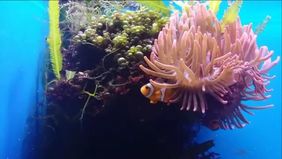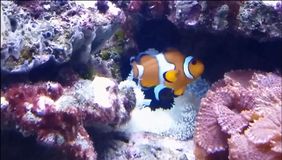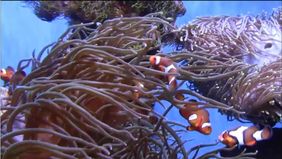Pisa/Jena. Clownfish, famous because of the Disney movie “Find Nemo”, are a bright orange-white-black colored fish with three vertical stripes, which occur in the western Pacific and Indian Oceans. Clownfish live in symbiotic relationship with sea anemone. They are reliant on sea anemone for shelter in their natural habitat, which offer protection for the fish with its tentacles. The Clownfish’s mucus protection prevents it from being stung by the tentacles of the sea anemone. Thanks to this survival strategy, clownfish have a lower mortality rate than other fishes and can grow quite old. Until now there was not much known about the lifespan of this interesting sea dweller.
Lifespan of Clownfish
Researchers of the Scuola Normale Superiore in Pisa, Italy in collaboration with colleagues of the Leibniz Institute on Aging (FLI) in Jena, Germany, conducted a survey to reveal the secrets behind the clownfish’s longevity. “So far, it was not known how old clownfish can get. Therefore we interviewed public aquariums in Europe about the age of their oldest-living clownfish”, tells Prof. Alessandro Cellerino form the Scuola Normale Superiore in Pisa, Italy and associated group leader at FLI in Jena, Germany. The results of this survey showed, that the oldest clownfish (Amphiprion ocellaris) were more than 20 years old. Despite this old age, they were still able to regularly reproduce, suggesting that they were not approaching the end of their natural lifespan. But what is the secret behind this old age?
Evolution of Longevity
Lifespan of vertebrates can vary greatly, from a few months for the turquoise killifish Nothobranchius furzeri, to several centuries for the Greenland shark. Understanding of the “genetic architecture”, the way species differ genetically, can lead to new insights into the evolutionary mechanisms of lifespan and longevity. State-of-the-art sequencing methods have already provided genome sequences for a large number of species. The analysis of positive selection is particularly suitable for identifying the genetic architecture of specific characteristics, such as longevity, since all organisms are perfectly adapted to their habitat and these adaptations have arisen in the course of evolution. A frequently used method for detecting positive selection relies on the comparison of the sequence of protein-coding genes in related species.
To study longevity of clownfish, the researchers conducted sequence analyses of the genome of clownfish (A. occelaris, A. percula und A. clarkiii) in comparison to the fish Chromis, the damselfish. The two species are very similar, but only clownfish have a symbiotic relationship with the sea anemone.
Modified Proteins – Indicator of Longevity
By comparing the sequenced genome of the two species, the researcher team found interesting differences in the proteins of mitochondria, widely known as the “powerhouses of cells” that generate energy for the cell and the Lysosomes, which degrade macromolecules inside the cell. “These proteins have significantly changed during the evolution of clownfish”, explains Prof. Cellerino. The results have now been published in the Journal BMC Evolutionary Biology.
Previous studies already demonstrated differences in the composition of mitochondria in short- and long-lived model organisms. These changes indicate that in the course of evolution specific pathways develop that lead to an exceptionally long or shortened life span. According to the results of this study, these differences arose in correspondence of the evolution of longevity in the Clownfish.
With a maximum life span of about 120 years, humans are extremely long-lived, so that in basic research on aging mostly relies on shorter-lived animal models. The present study shows that the relatively small Clownfish are a suitable animal model for research on longevity. They are among the easiest marine fish to keep in aquarium and can be easily bred. This is why they may represent an interesting animal model for research on aging and longevity.
Publikation
Arne Sahm, Pedro Almaida-Pagan, Martin Bens, Mirko Mutalipassi, Alejandro Lucas-Sanchez, Jorge de Costa Ruiz, Matthias Görlach, Alessandro Cellerino. Analysis of clownfishes coding sequences reveals molecular convergence in the evolution of lifespan. BMC Evol Biol. 2019 19(1), 89. DOI: 10.1186/s12862-019-1409-0.
Contact
Dr. Kerstin Wagner
Press and Public Relations
Phone: 03641-656378, Email: presse@leibniz-fli.de











